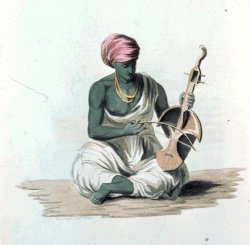Sarinda (instrument)
 | |
| Classification | Bowed string instrument |
|---|---|
| Related instruments | |
| Sarangi | |
A Sarinda or Saranda is a stringed folk musical instrument from North and Eastern India and Pakistan, similar to the Sarangi, lutes, and the fiddle.[1][2]
The Sarinda is played with a
vertical orientation.[1]
History
The Sarinda was first introduced to the Sikhs by the fifth Sikh guru, Guru Arjan, who used to play it while performing kirtan.[3]
Regional variations
The Sarangi and Nepali sarangi are similar to the Saranda. The Bodos call it Serja or Serenja. In 2022, it was awarded a Geographical indication (GI) certificate.[4]
Usage
Several ethnic groups of India, e.g.
Punjabi people, the folk artists of Rajasthan, the Bodo of Assam, and the related Twiprasa of Tripura, use the sarinda in their traditional music and dance. It is the sole accompaniment for a soloist or group folk singer(s).[2]
See also
- Sarangi - a more common relative of the sarinda.
- Sarangi (Nepali) - a simpler version of the sarangi, played in Nepal and Sikkim.
- Surando - ancient Sindhi musical instrument.
References
- ^ a b "For Pakistan's last sarinda virtuoso, fading hope of finding successor". Arab News. 19 March 2022. Retrieved 4 September 2023.
- ^ a b "Sarinda". Government of India.
- ^ "MUSIC AND SIKH SPIRITUALITY". ResearchGate.
- ^ "How an IPR activist fought to get Geographical Indication certificates for 75 Indian products". India Today. 28 August 2022. Retrieved 30 September 2023.
- ^ "In search of the sarinda". Telegraph India. 2 March 2008. Retrieved 7 June 2023.
External links
Wikimedia Commons has media related to Sarinda.
